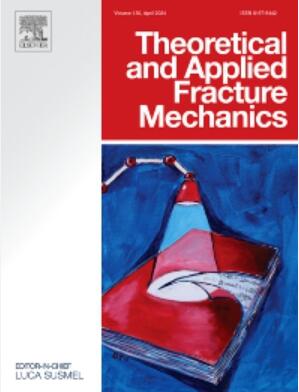霜胀压力作用下岩石裂纹扩展的模拟算法
IF 5
2区 工程技术
Q1 ENGINEERING, MECHANICAL
引用次数: 0
摘要
在冻胀压力作用下岩石内部的裂纹扩展是威胁岩石工程安全的主要因素之一。现有的霜裂模拟算法难以模拟裂缝的真实形态,且大多局限于样本尺度。为此,提出了一种新的模拟岩石在霜胀压力下裂纹扩展的算法。该算法能生成形态逼真的霜裂缝,适用于多尺度岩石。基于Griffith准则,考虑应力集中效应,在二维平面上模拟霜裂。采用Minkowski函数量化冻融循环次数、初始裂缝、计算域边界条件等因素对冻融裂缝的影响。在数值模拟软件中提取产生的裂缝的坐标信息,建立裂隙岩体模型。该算法已扩展到各种尺度,以探索霜裂对岩样变形特性和边坡稳定性的影响。该算法可以清晰地描述霜裂的演化过程,为评价岩石工程的安全性提供参考。本文章由计算机程序翻译,如有差异,请以英文原文为准。
A simulation algorithm for crack propagation in rocks subjected to frost swelling pressure
The crack propagation inside rocks subjected to frost swelling pressure is one of the main factors threatening the safety of rock engineering. The existing frost crack simulation algorithms are difficult to model the real shapes of cracks, and most of them are limited to the sample scale. Therefore, a novel algorithm for simulating crack propagation in rocks under frost swelling pressure is proposed. The proposed algorithm can generate frost cracks with realistic morphology and is applicable to rocks at multiple scales. The stress concentration effect is involved to simulate frost cracks in a two-dimensional plane based on Griffith criterion. The Minkowski function is employed to quantify the impact of various factors on frost cracks, including the number of freeze–thaw cycles, initial crack, and the boundary condition of the computational domain. Moreover, the coordinate information of the generated cracks can be extracted to establish the fractured rock model in numerical simulation software. The algorithm has been extended to various scales to explore the impact of frost cracks on the deformation properties of rock samples and slope stability. The proposed algorithm can clarify the evolution process of frost cracks, providing references for evaluating the safety of rock engineering.
求助全文
通过发布文献求助,成功后即可免费获取论文全文。
去求助
来源期刊

Theoretical and Applied Fracture Mechanics
工程技术-工程:机械
CiteScore
8.40
自引率
18.90%
发文量
435
审稿时长
37 days
期刊介绍:
Theoretical and Applied Fracture Mechanics'' aims & scopes have been re-designed to cover both the theoretical, applied, and numerical aspects associated with those cracking related phenomena taking place, at a micro-, meso-, and macroscopic level, in materials/components/structures of any kind.
The journal aims to cover the cracking/mechanical behaviour of materials/components/structures in those situations involving both time-independent and time-dependent system of external forces/moments (such as, for instance, quasi-static, impulsive, impact, blasting, creep, contact, and fatigue loading). Since, under the above circumstances, the mechanical behaviour of cracked materials/components/structures is also affected by the environmental conditions, the journal would consider also those theoretical/experimental research works investigating the effect of external variables such as, for instance, the effect of corrosive environments as well as of high/low-temperature.
 求助内容:
求助内容: 应助结果提醒方式:
应助结果提醒方式:


